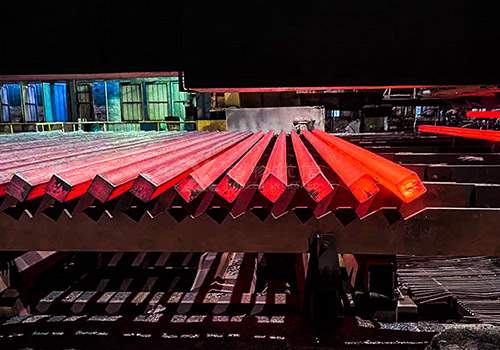
Key Q235 Material Properties That Affect Performance
Introduction
Q235 steel is a low carbon structural steel widely used in construction and engineering applications due to its excellent weldability and machinability. Understanding the Q235 material properties is crucial for engineers, designers, and manufacturers as it directly impacts the performance, durability, and safety of structures. This blog aims to explore the key properties of Q235 material, providing insights into its chemical composition, mechanical properties, applications, and factors affecting performance.
Understanding Q235 Material Properties

Chemical Composition of Q235 Material
The chemical composition of Q235 material plays a crucial role in determining its properties and performance. It typically contains:
- Carbon (C): 0.14-0.22%
- Silicon (Si): ≤0.35%
- Manganese (Mn): 0.30-0.70%
- Phosphorus (P): ≤0.045%
- Sulfur (S): ≤0.045%
These elements work together to give the steel its strength, toughness, and weldability .
Mechanical Properties of Q235 Material
The mechanical properties of Q235 material are essential for its performance in various applications. Some key mechanical properties include:
- Yield Strength: 235 MPa
- Tensile Strength: 370-500 MPa
- Elongation: 20-26% depending on the thickness
These properties make Q235 material suitable for applications requiring high strength and durability .
Physical Properties of Q235 Material
Physical properties such as density, melting point, specific heat capacity, and electrical resistivity also affect the performance of Q235 material. For instance:
- Density: 7.85 g/cm³ (0.284 lb/in³)
- Melting point: 1450-1530 °C (2640-2800 °F)
- Specific heat capacity: 470 J/(Kg·K) at 20 °C (68 °F)
- Electrical resistivity: about 0.15 μΩ·m (20 °C)
These properties influence how Q235 material behaves under different conditions and during processing .
Mechanical Properties of Q235
The mechanical properties of Q235 steel include its yield strength, tensile strength, elongation, and hardness. These properties significantly influence its performance in structural applications. Here is a table summarizing the key mechanical properties of Q235:
| Property | Value |
|---|---|
| Yield Strength | 235 MPa (Min) |
| Tensile Strength | 370-500 MPa |
| Elongation | 21% (Min) |
| Hardness | 131 HB (Max) |
| Impact Toughness | 34 J at -20°C |
Yield Strength and Tensile Strength
Yield strength refers to the maximum stress a material can withstand without permanent deformation. For Q235, the minimum yield strength is 235 MPa, making it suitable for a variety of structural applications. Tensile strength, on the other hand, is the maximum stress a material can bear before failure, ranging between 370-500 MPa for Q235. These strengths ensure that Q235 can handle various loads and stresses in structural applications.
Applications of Q235 Material
The versatility of Q235 material is evident in its wide range of applications, including:
- Construction industry: Structural beams, columns, bridges, building frames, reinforcing bars, purlins, roofing structures, scaffolding, and railway tracks.
- Machinery and automotive: Machine frames and parts, chassis components, automotive frames and panels, gearboxes, engine components, and agricultural machinery.
- Everyday items: Metal furniture frames, shelving units, storage racks, kitchen equipment, industrial racks, storage solutions, tool cabinets, workbenches, office desks, and chairs .
Q235 Material Grades Comparison
Q235 material comes in different grades (A, B, C, and D), each with specific properties that affect their performance:
| Grade | Carbon (C %) | Silicon (Si %) | Manganese (Mn %) | Phosphorus (P %) | Sulfur (S %) |
|---|---|---|---|---|---|
| Q235A | 0.22 | 0.35 | 1.4 | 0.045 | 0.05 |
| Q235B | 0.20 | 0.35 | 1.4 | 0.045 | 0.045 |
| Q235C | 0.17 | 0.35 | 1.4 | 0.04 | 0.04 |
| Q235D | 0.17 | 0.35 | 1.4 | 0.035 | 0.035 |
The quality of Q235 material improves from grade A to grade D, with lower carbon content enhancing flexibility and reduced phosphorus and sulfur contents improving toughness and weldability .
Factors Affecting Q235 Material Properties

Manufacturing Process
The manufacturing process of Q235 steel, including casting, rolling, and heat treatment, can influence its mechanical properties. For instance, proper heat treatment can improve the tensile strength and ductility of the material, making it more suitable for specific applications.
Environmental Conditions
The environment in which Q235 is used can impact its performance. Exposure to corrosive elements, temperature variations, and humidity can affect the steel’s durability. Therefore, selecting appropriate coatings or treatments is essential based on the expected environmental conditions.
Load Conditions
The type of loads applied to Q235 structures—static or dynamic—also affects its performance. Understanding the nature of these loads allows engineers to design structures that can withstand the stresses without compromising safety or integrity.
Conclusion
Q235 material is a versatile and cost-effective carbon structural steel with a range of properties that make it suitable for various applications. Its chemical composition, mechanical properties, and physical properties all contribute to its performance. The different grades of Q235 material offer varying levels of quality, making it adaptable to specific project requirements. Understanding these properties is crucial for selecting the right grade of Q235 material for any given application.
FAQ
What is the impact of corrosion on Q235 material properties?
Corrosion can significantly affect the strength and carrying capacity of Q235 material. As the corrosion rate increases, the yield strength, ultimate strength, and ductility of Q235 material decrease .
How does heat treatment affect Q235 material properties?
Heat treatment can enhance the mechanical properties of Q235 material by altering its microstructure. This can lead to improved strength, toughness, and ductility .
Can Q235 material be used in high-temperature applications?
Q235 material has a melting point of around 1450-1530 °C, making it suitable for high-temperature applications. However, its performance can degrade at very high temperatures, and it may require additional protective measures .
What are the advantages of using Q235 material?
Q235 material is cost-effective, highly available, and offers excellent weldability, machinability, and versatility. Its high tensile strength and good ductility make it suitable for a wide range of applications .






